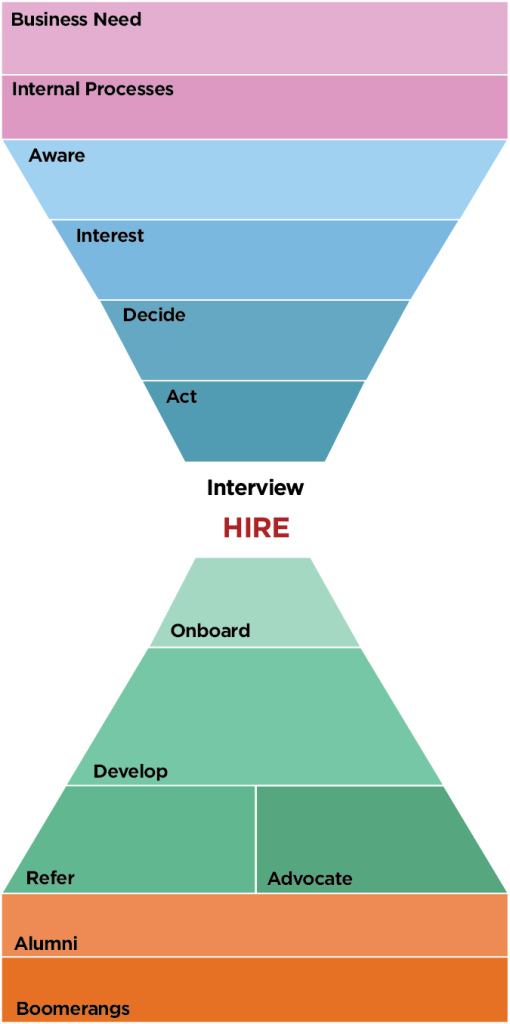It wasn’t so long ago that the concept of a marketing funnel (or consideration funnel) was a bit of a revolution. Injecting more marketing thinking into the world of “post and pray” and sourcing-focused sales, the funnel was a way of looking at our recruiting challenges at a more macro level, enabling big ideas like content marketing, lead-generation, social recruiting, and employer branding to become part of almost everyone’s recruiting strategy.
The funnel is a macro-focus on each candidate’s internal process of deciding to apply for and accept a new role. That funnel, as seen on a million decks, generally looks like this:

Over the last five years, the adoption of the funnel has facilitated better conversations and better strategies in thousands, if not millions, of companies. It has helped us shed practices left over from a pre-digital age.
That said, the consideration funnel has serious limitations. Seen through its lens, most recruiting and hiring problems come in two forms: “top of the funnel” issues and “holes in the funnel” issues. Having issues hiring? Get more applications and keep them from falling out, right? Look at most recruiting tools and solutions being offered today: get some employer branding to increase awareness, train your recruiters how to use social media, build content and share it like crazy, enhance the candidate experience, etc. These are all obvious solutions when all you can see is the consideration funnel.
The biggest issue with this funnel is that the tools connected to it are resource-intensive. The funnel turns recruiting into a game of who can spend the most to attract and convince people to apply. And unless you are Google or Amazon, this is not a game you can win.
But there is another way to approach recruiting, one that sees a far-larger picture than simply getting strangers to apply. This new model takes into consideration the entire recruiting talent process to maximize your ability to bring new talent within your organization across the entire lifecycle.
This is the Comprehensive Talent Funnel.

The first things to notice are that it doesn’t start at the point at which you push out a job posting or branding campaign. It starts at the true source of all talent: a business need.
This may see obvious to those of us within HR, but neglecting its inclusion allows recruiters and hiring managers to forget how they are on the same page, that they have the same goal: hire someone who solves a business problem and grows the business. Starting at the business need puts the rest of the model on more solid footing.
Next, we need to acknowledge all the internal processes that go into turning that business need into a job posting. Depending on the size of the organization, this can include salary ranges, leveling, HR business partners, the intake meeting with the hiring manager, the writing of the job description ,and decisions as to where and how to publicize the opportunity. Broken processes here lead to poorly-aligned jobs with mis-managed expectations and will likely lead to internal frustration that never attracts great talent.
Then we return to the usual consideration funnel, which is still completely valid. But there are a lot more steps beyond the hire which are usually ignored.
First, great talent starts with great onboarding. It is the head-start that puts someone in a position to add value to the business in the shortest period of time. The knock-on effect of smart onboarding is that it shortens the time before they can be eligible for development, where new skills can be added and they can position themselves for promotion. Including this step highlights how talent can be grown from within and doesn’t always have to be “found” outside. Adding development to the funnel puts internal mobility on the same footing as sourcing and lets you as the talent leader to compare apples to apples when it comes to budgets for each department.
Employees who are developed and feel developed can be asked to refer prospects to recruiters and advocate for the brand. These steps are independent, but connected, and should be considered in tandem. Advocacy is a core element to communicating and amplifying your employer brand. Referrals are classically the best source of long-tenured employees and need to be considered as part of the overall recruiting strategy.
In the last section, we have the talent that exists outside our organization. Fifteen years ago, when someone left your organization, it was often considered a betrayal to take a new job. Today, as mobility is absolutely the norm, taking such a negative attitude towards our alumni eliminates those networks of people and a powerful tool in communicating your employer brand.
Also, alumni are the source of most of our negative Glassdoor reviews. By changing alumni strategy and embracing their past role at our company, we can soften or even negate those review, making clear impact on our ratings.
Finally, unless we embrace our alumni, we won’t be able to take advantage of one of the biggest trends in talent management: creating boomerangs. It wasn’t long ago that boomerangs were rare, but they are quickly becoming commonplace. Wouldn’t you want someone who knows your company, knows how things are done, has seen more companies and chosen to return? This is talent you simply can’t afford to ignore.
By looking at your talent issues through this new lens, you can ask how each step impacts your hiring or how you can adjust each step to maximize your complete talent ecosystem. This expanded model changes the conversation, implying, if not outright demanding, that every part of HR and the organization as a whole has crucial roles to play in hiring.
This article is connected to this week’s episode of The Talent Cast (below).
This idea is a framework in beta, meaning that if you have questions, suggestions, clarification, additions, join the conversation on Twitter: @TheWarForTalent and see me speak at ERE San Diego. And if you found this article interesting, you will find similar insights and ideas from James on The Talent Cast (available wherever you get podcasts).
All diagrams by James Ellis
